
|
Now it is so bright as 4.4 mag (Jan. 2, Marco Goiato). It is visible with naked eyes. In the Northern Hemisphere, it keeps observable in good condition after this until the comet fades out. In the Southern Hemisphere, it is observable only until late January.
Date(TT) R.A. (2000) Decl. Delta r Elong. m1 Best Time(A, h)
Jan. 3 4 49.94 -14 44.8 0.482 1.353 131 4.5 21:55 ( 0, 42)
Jan. 10 4 1.62 2 32.9 0.474 1.325 127 4.3 20:40 ( 0, 59)
|
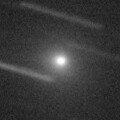
|
It brightened very rapidly in outburst up to 8.8 mag on Dec. 19 (Marco Goiato). It is bright as 10.4 mag still now (Dec. 28, Carlos Labordena). It keeps 9-10 mag until January. In the Northern Hemisphere, it will be geting higher gradually. In the Southern Hemisphere, it keeps locating extremely low after this.
Date(TT) R.A. (2000) Decl. Delta r Elong. m1 Best Time(A, h)
Jan. 3 21 54.46 -13 0.1 1.407 0.981 44 10.2 18:30 ( 55, 22)
Jan. 10 22 26.05 -9 15.6 1.394 0.997 45 10.0 18:35 ( 58, 25)
|

|
It brightened up to 6.9 mag in autumn (Oct. 17, Marco Goiato). Now it is fading. But it is bright as 11.0 mag still now (Dec. 29, Chris Wyatt). In the Northern Hemisphere, it keeps observable in the evening low sky until early February. It is getting lower also in the Southern Hemisphere, and will be unobservable temporarily in March. But it will be observable in good condition again after April.
Date(TT) R.A. (2000) Decl. Delta r Elong. m1 Best Time(A, h)
Jan. 3 0 8.64 -33 0.0 2.378 2.223 68 10.6 18:30 ( 16, 20)
Jan. 10 0 7.23 -30 53.8 2.576 2.306 63 10.9 18:35 ( 24, 20)
|
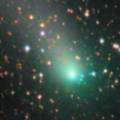
|
The brightness evolution has slowed down before the perihelion passage, and it faded down to 11.6 mag in late October (Oct. 26, Todd Augustyniak). However, an outburst occured around Nov. 10-12, and it brightened by 2 mag. It is bright as 10.4 mag still now (Nov. 29, Seiichi Yoshida). In the Northern Hemisphere, it is getting higher rapidly in the morning sky, and it will be observable in excellent condition after this while the comet will be fading. In the Southern Hemisphere, it is not observable until mid February.
Date(TT) R.A. (2000) Decl. Delta r Elong. m1 Best Time(A, h)
Jan. 3 17 58.99 1 38.2 2.524 1.716 27 10.9 5:38 (273, 6)
Jan. 10 18 1.24 3 55.4 2.518 1.774 32 11.0 5:38 (274, 13)
|

|
Now it is 15.1 mag (Dec. 16, Ken-ichi Kadota). It will brighten up to 8-9 mag in 2015 spring. In the Southern Hemisphere, it will be getting higher gradually after this. In the Northern Hemisphere, it keeps extremely low and hard to observe until June. It will be observable in good condition after June while the comet will be fading gradually.
Date(TT) R.A. (2000) Decl. Delta r Elong. m1 Best Time(A, h)
Jan. 3 16 28.95 -21 26.6 2.419 1.684 33 12.0 5:38 (305, 9)
Jan. 10 16 50.81 -22 20.0 2.347 1.643 35 11.7 5:38 (306, 10)
|
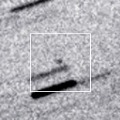
|
Now it is 16.0 mag (Dec. 22, Ken-ichi Kadota). It will brighten very rapidly, and will brighten up to 11 mag from January to February. In the Southern Hemisphere, it will be observable in the morning sky after February while the comet will be fading. It is hardly observable in the Northern Hemisphere.
Date(TT) R.A. (2000) Decl. Delta r Elong. m1 Best Time(A, h)
Jan. 3 17 19.58 -16 6.8 2.132 1.285 22 12.6 5:38 (293, 4)
Jan. 10 17 46.17 -17 39.5 2.108 1.265 23 12.2 5:38 (294, 3)
|

|
Now it is so bright as 10.9 mag (Dec. 20, Marek Biely). It will be fading graudually after this. But it keeps observable for a long time until the comet fades out.
Date(TT) R.A. (2000) Decl. Delta r Elong. m1 Best Time(A, h)
Jan. 3 15 15.21 -9 47.6 1.857 1.496 53 12.3 5:38 (310, 30)
Jan. 10 15 34.38 -10 52.4 1.867 1.543 55 12.5 5:38 (313, 31)
|
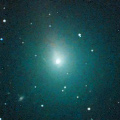
|
It brightened rapidly, and reached up to 10.3 mag in autumn (Oct. 22, Bob King). Now it is fading rapidly. It has already faded down to 13.9 mag (Dec. 9, Mitsunori Tsumura). In the Northern Hemisphere, it keeps observable in good condition until the comet fades out in spring. It is not observable in the Southern Hemisphere.
Date(TT) R.A. (2000) Decl. Delta r Elong. m1 Best Time(A, h)
Jan. 3 19 14.55 46 25.7 1.829 1.747 69 13.1 18:30 (131, 24)
Jan. 10 19 20.68 44 45.2 1.919 1.779 66 13.7 5:38 (229, 20)
|

|
It brightened up to 6.5 mag in September (Sept. 21, Marco Goiato). Now it is fading. It has already faded down to 14.9 mag (Jan. 2, Taras Prystavski). It keeps observable in good condition after this, while the comet will be fading gradually.
Date(TT) R.A. (2000) Decl. Delta r Elong. m1 Best Time(A, h)
Jan. 3 16 2.42 -3 7.3 2.440 1.888 45 13.2 5:38 (295, 27)
Jan. 10 16 2.33 -1 40.8 2.422 1.989 52 13.4 5:38 (300, 33)
|
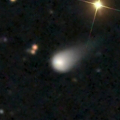
|
Now it is 13.6 mag (Dec. 19, Chris Wyatt). Getting brighter than originally expected, and it is already visible visually. It is expected to brighten up to 4 mag from autumn to winter in 2015. It will be unobservable soon. In the Southern Hemisphere, it will be observable in good condition again after late March. In the Northern Hemisphere, it is hardly observable until 2015 December.
Date(TT) R.A. (2000) Decl. Delta r Elong. m1 Best Time(A, h)
Jan. 3 22 25.00 -24 41.0 5.029 4.437 48 13.5 18:30 ( 41, 17)
Jan. 10 22 26.98 -24 24.2 5.043 4.363 42 13.4 18:35 ( 47, 13)
|

|
Now it is 13.8 mag (Dec. 29, Chris Wyatt). It is fainter than originally predicted by 2 mag. In the Northern Hemisphere, it keeps observable at 14 mag in excellent condition from 2014 summer to 2015 spring. It locates somewhat low in the Southern Hemisphere.
Date(TT) R.A. (2000) Decl. Delta r Elong. m1 Best Time(A, h)
Jan. 3 11 42.55 16 52.1 1.542 2.119 112 13.9 4:54 ( 0, 72)
Jan. 10 11 47.71 16 59.4 1.495 2.140 117 13.8 4:32 ( 0, 72)
|

|
It is getting higher gradually in the morning sky.
Date(TT) R.A. (2000) Decl. Delta r Elong. m1 Best Time(A, h)
Jan. 3 17 4.80 -29 50.8 6.958 6.081 25 14.1 5:38 (305, -2)
Jan. 10 17 10.77 -29 58.9 6.904 6.079 30 14.1 5:38 (309, 1)
|
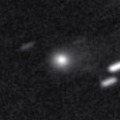
|
It is getting higher gradually in the morning sky. In 2015, it keeps 13 mag and will be observable in good condition for a long time.
Date(TT) R.A. (2000) Decl. Delta r Elong. m1 Best Time(A, h)
Jan. 3 17 2.12 -13 36.6 4.404 3.564 27 14.2 5:38 (293, 9)
Jan. 10 17 12.78 -13 44.2 4.344 3.548 32 14.2 5:38 (296, 12)
|
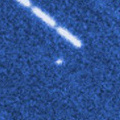
|
Now it is 16.2 mag (Dec. 12, Taras Prystavski). It will brighten up to 9 mag in 2015 spring. But the condition of this apparition is bad. It will be getting lower gradually, and will be unobservable in late January in the Northern Hemisphere, or in mid March in the Southern Hemisphere. In the Northern Hemisphere, it will be observable after 2015 autumn while the comet will be fading.
Date(TT) R.A. (2000) Decl. Delta r Elong. m1 Best Time(A, h)
Jan. 3 22 17.19 -35 53.0 2.638 2.078 45 14.5 18:30 ( 36, 7)
Jan. 10 22 31.81 -33 59.3 2.634 2.027 42 14.3 18:35 ( 40, 7)
|
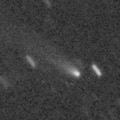
|
Now it is 14.8 mag (Dec. 12, Mike Wolle). It will be observable at 14 mag in excellent condition in winter.
Date(TT) R.A. (2000) Decl. Delta r Elong. m1 Best Time(A, h)
Jan. 3 0 12.36 3 58.3 1.059 1.346 82 14.6 18:30 ( 31, 56)
Jan. 10 0 31.61 6 51.3 1.082 1.340 80 14.6 18:35 ( 38, 56)
|
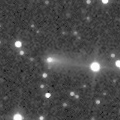
|
Now it is 14.2 mag (Dec. 20, Taras Prystavski). It keeps 15 mag until February, and it will be observable in excellent condition in the Northern Hemisphere. It locates somewhat low in the Southern Hemisphere.
Date(TT) R.A. (2000) Decl. Delta r Elong. m1 Best Time(A, h)
Jan. 3 6 40.67 25 38.8 1.495 2.477 176 14.9 23:49 ( 0, 81)
Jan. 10 6 34.49 25 2.7 1.508 2.479 168 14.9 23:15 ( 0, 80)
|

|
It brightened rapidly in outburst in mid October in 2013. Now it is fading. It has already faded down to 13.6 mag (Dec. 12, Taras Prystavski). In the Southern Hemisphere, it will be low temprarily from February to March. But it keeps observable in good condition for a long time after this until the comet fades out. It is not observable in the Northern Hemisphere.
Date(TT) R.A. (2000) Decl. Delta r Elong. m1 Best Time(A, h)
Jan. 3 22 48.17 -40 45.3 4.600 4.071 52 14.9 18:30 ( 28, 7)
Jan. 10 22 56.28 -39 54.9 4.725 4.136 48 15.1 18:35 ( 32, 5)
|

|
Now it is 14.5 mag (Dec. 24, Taras Prystavski). It keeps 15 mag for a long time from 2014 to 2015. It is observable in excellent condition in 2014 in the Southern Hemisphere, or in 2015 in the Northern Hemisphere.
Date(TT) R.A. (2000) Decl. Delta r Elong. m1 Best Time(A, h)
Jan. 3 0 11.93 -16 11.1 4.072 3.929 74 15.0 18:30 ( 21, 36)
Jan. 10 0 13.89 -14 24.8 4.166 3.920 68 15.0 18:35 ( 30, 35)
|
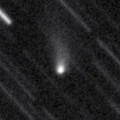
|
Now it is 15.6 mag (Dec. 12, Taras Prystavski). The brightness evolution is somewhat slow. It keeps 15-16 mag for a long time from 2014 autumn to 2015 autumn. In the Southern Hemisphere, it keeps observable in excellent condition for a long time. In the Northern Hemisphere, it is unobservable until 2015 June.
Date(TT) R.A. (2000) Decl. Delta r Elong. m1 Best Time(A, h)
Jan. 3 3 26.89 -74 38.2 2.102 2.113 77 15.0 20:30 ( 0,-19)
Jan. 10 2 22.79 -71 7.5 2.135 2.088 73 15.0 19:01 ( 0,-16)
|

|
It brightened up to 11-12 mag in 2012. It has already faded down to 15.5 mag (Dec. 24, Taras Prystavski). It keeps observable at 15 mag in good condition until 2015 summer.
Date(TT) R.A. (2000) Decl. Delta r Elong. m1 Best Time(A, h)
Jan. 3 12 5.63 -10 34.3 8.599 8.764 96 15.1 5:17 ( 0, 44)
Jan. 10 12 3.61 -10 33.5 8.513 8.802 103 15.1 4:48 ( 0, 44)
|
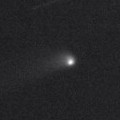
|
Now it is 15.2 mag (Dec. 28, Taras Prystavski). It will brighten up to 14 mag from 2015 to 2016. It is observable in good condition in the Southern Hemisphere. It locates somewhat low in the Northern Hemisphere.
Date(TT) R.A. (2000) Decl. Delta r Elong. m1 Best Time(A, h)
Jan. 3 3 21.08 -21 5.3 4.193 4.656 112 15.3 20:30 ( 0, 34)
Jan. 10 3 13.51 -19 49.7 4.262 4.631 106 15.3 19:55 ( 0, 35)
|
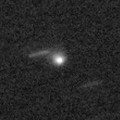
|
It will approach to the sun down to 0.3 a.u. in 2015 July, and it is expected to be bright. Now it is 15.3 mag (Dec. 20, Taras Prystavski). It keeps observable while the comet will be brightening gradually until January when the comet will be 15 mag. The condition is bad after that and it will be hard to observe. But in the Southern Hemisphere, it will be observable after mid July in 2015, and keeps observable while the comet will be fading gradually. In the Northern Hemisphere, it is extremely hard to observe after 2015.
Date(TT) R.A. (2000) Decl. Delta r Elong. m1 Best Time(A, h)
Jan. 3 22 54.07 -22 14.7 3.737 3.280 55 15.5 18:30 ( 37, 23)
Jan. 10 22 57.67 -21 8.7 3.738 3.190 49 15.4 18:35 ( 44, 20)
|

|
Now it is 14.5 mag (Nov. 19, Taras Prystavski). It will be unobservable temporarily in winter, but it will be observable at 15-16 mag in good condition again in 2015.
Date(TT) R.A. (2000) Decl. Delta r Elong. m1 Best Time(A, h)
Jan. 3 18 41.82 -15 5.1 8.171 7.200 8 15.4 5:38 (280,-12)
Jan. 10 18 44.46 -15 21.0 8.188 7.227 11 15.5 5:38 (284, -7)
|

|
Now it is 15.2 mag (Dec. 20, Taras Prystavski). It will be unobservable soon.
Date(TT) R.A. (2000) Decl. Delta r Elong. m1 Best Time(A, h)
Jan. 3 21 58.37 -20 3.6 3.991 3.342 43 15.4 18:30 ( 49, 17)
Jan. 10 22 7.49 -19 7.0 4.069 3.355 38 15.5 18:35 ( 54, 14)
|
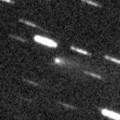
|
Now it is 15.1 mag (Dec. 30, Mitsunori Tsumura). It keeps observable for a long time after this while the comet will be fading gradually.
Date(TT) R.A. (2000) Decl. Delta r Elong. m1 Best Time(A, h)
Jan. 3 9 58.66 0 8.7 1.863 2.600 129 15.6 3:11 ( 0, 55)
Jan. 10 9 55.38 0 14.7 1.837 2.643 136 15.7 2:40 ( 0, 55)
|
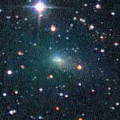
|
Now it is 13.8 mag (Dec. 20, Taras Prystavski). It keeps observable in excellent condition in the Northern Hemisphere. But it will be fading after this. It locates low in the Southern Hemisphere.
Date(TT) R.A. (2000) Decl. Delta r Elong. m1 Best Time(A, h)
Jan. 3 5 1.19 38 50.0 0.935 1.859 151 15.6 22:10 (180, 86)
Jan. 10 5 0.07 39 10.6 0.993 1.886 145 15.9 21:42 (180, 86)
|
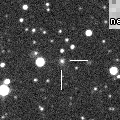
|
Now it is 15.5 mag (Dec. 13, Taras Prystavski). In the Northern Hemisphere, it keeps 15-16 mag and observable in excellent condition for a long time until early summer in 2015. It locates somewhat low in the Southern Hemisphere.
Date(TT) R.A. (2000) Decl. Delta r Elong. m1 Best Time(A, h)
Jan. 3 13 22.24 32 41.7 3.342 3.585 96 15.7 5:38 (278, 78)
Jan. 10 13 27.05 32 47.1 3.280 3.599 100 15.6 5:38 (287, 83)
|
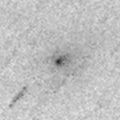
|
Now it is 15.4 mag (Nov. 19, Taras Prystavski). Extremely diffuse. It will be fading after this, and will be fainter than 18 mag in late March. It keeps observable in excellent condition in the Southern Hemisphere. But it locates low in the Northern Hemisphere.
Date(TT) R.A. (2000) Decl. Delta r Elong. m1 Best Time(A, h)
Jan. 3 9 33.02 -26 47.0 1.397 2.041 116 15.8 2:45 ( 0, 28)
Jan. 10 9 26.68 -30 8.4 1.408 2.082 119 15.9 2:11 ( 0, 25)
|

|
Now it is 15.3 mag (Dec. 19, Taras Prystavski). It is already unobservable in the Southern Hemisphere. It will be unobservable in mid February also in the Northern Hemisphere. But it will be observable again at 17 mag from summer to autumn. The fragment B is still visible at 18.3 mag (Dec. 31, E. Bryssinck).
Date(TT) R.A. (2000) Decl. Delta r Elong. m1 Best Time(A, h)
Jan. 3 22 43.19 17 43.0 5.060 4.804 69 15.8 18:30 ( 74, 51)
Jan. 10 22 46.22 16 50.9 5.210 4.846 63 15.9 18:35 ( 79, 45)
|
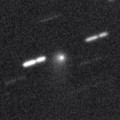
|
Now it is 15.7 mag (Dec. 20, Taras Prystavski). It keeps observable at 15-16 mag for a long time from 2015 to 2016. In the Northern Hemisphere, it is observable in excellent condition. It locates somewhat low in the Southern Hemisphere.
Date(TT) R.A. (2000) Decl. Delta r Elong. m1 Best Time(A, h)
Jan. 3 3 3.65 27 27.4 4.924 5.589 128 15.9 20:13 ( 0, 83)
Jan. 10 3 0.51 27 49.7 5.001 5.570 120 16.0 19:42 ( 0, 83)
|
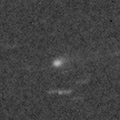
|
Now it is 16.3 mag (Dec. 20, Taras Prystavski). It will brighten up to 16 mag and will be observable in excellent condition in winter.
Date(TT) R.A. (2000) Decl. Delta r Elong. m1 Best Time(A, h)
Jan. 3 12 1.38 4 45.3 1.633 2.095 103 16.1 5:13 ( 0, 60)
Jan. 10 12 8.21 4 36.7 1.575 2.112 109 16.1 4:52 ( 0, 60)
|
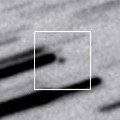
|
Now it is 15.3 mag (Nov. 27, Mt. Lemmon Survey). It will pass the perihelion on Mar. 15. In the Northern Hemispehre, it keeps observable in good condition until late February. In the Southern Hemisphere, it keeps observable until mid February, but it locates low.
Date(TT) R.A. (2000) Decl. Delta r Elong. m1 Best Time(A, h)
Jan. 3 1 44.07 21 38.8 0.793 1.455 109 16.2 18:53 ( 0, 77)
Jan. 10 1 31.33 18 18.5 0.818 1.370 98 16.3 18:35 ( 18, 72)
|
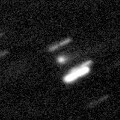
|
Now it is 16.6 mag (Dec. 27, Takaaki Oribe). It will brighten up to 16 mag in winter, and will be observable in excellent condition.
Date(TT) R.A. (2000) Decl. Delta r Elong. m1 Best Time(A, h)
Jan. 3 8 19.75 12 48.8 3.166 4.089 156 16.3 1:32 ( 0, 68)
Jan. 10 8 16.30 12 50.5 3.136 4.092 164 16.3 1:01 ( 0, 68)
|
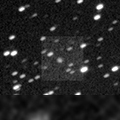
|
Now it is 15.8 mag (Dec. 19, Taras Prystavski). It will pass close to the earth from spring to summer in 2016, and it is expected to be observable at 6-7 mag in good condition. In the Northern Hemispehre, it keeps observable in good condition until 2015 spring when the comet will brighten up to 15.5 mag. In the Southern Hemisphere, it keeps low for a long time until 2016 spring.
Date(TT) R.A. (2000) Decl. Delta r Elong. m1 Best Time(A, h)
Jan. 3 5 48.12 36 48.5 4.731 5.666 160 16.4 22:56 (180, 88)
Jan. 10 5 38.84 36 45.4 4.709 5.603 153 16.3 22:20 (180, 88)
|

|
Now it is 15.6 mag (Dec. 20, Taras Prystavski). It will be higher gradually, and will be observable at 16-17 mag in good condition from winter to spring.
Date(TT) R.A. (2000) Decl. Delta r Elong. m1 Best Time(A, h)
Jan. 3 15 18.97 -9 7.6 2.307 1.883 52 16.4 5:38 (309, 30)
Jan. 10 15 35.46 -9 46.2 2.273 1.903 55 16.5 5:38 (312, 31)
|

|
Now it is 17.8 mag (Dec. 29, K. Hills). It will brighten up to 13 mag in 2016. In the Northern Hemisphere, it will be observable in excellent condition in this winter. It locates somewhat low in the Southern Hemisphere. It is fainter than this ephemeris recently.
Date(TT) R.A. (2000) Decl. Delta r Elong. m1 Best Time(A, h)
Jan. 3 6 5.96 28 23.9 2.235 3.203 168 16.6 23:14 ( 0, 83)
Jan. 10 5 59.54 28 23.6 2.236 3.178 160 16.5 22:40 ( 0, 83)
|

|
It brightened up to 13.7 mag in autumn (Sept. 16, Taras Prystavski). Now it is fading. But it is bright as 15.9 mag still now (Dec. 20, Taras Prystavski). It keeps observable until March when it becomes fainter than 18 mag.
Date(TT) R.A. (2000) Decl. Delta r Elong. m1 Best Time(A, h)
Jan. 3 0 24.33 -8 55.3 2.408 2.439 80 16.7 18:30 ( 19, 44)
Jan. 10 0 33.70 -7 43.7 2.506 2.456 75 16.8 18:35 ( 28, 43)
|
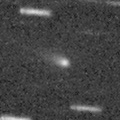
|
First return of a new periodic comet discovered in 2004. It brightened very rapidly as expected. Now it is 16.2 mag (Dec. 20, Taras Prystavski). It will be fading rapidly after this, and will be fainter than 18 mag in late January.
Date(TT) R.A. (2000) Decl. Delta r Elong. m1 Best Time(A, h)
Jan. 3 1 9.43 8 7.4 1.019 1.500 97 16.9 18:30 ( 5, 63)
Jan. 10 1 31.58 8 53.4 1.087 1.531 95 17.2 18:35 ( 12, 64)
|

|
Now it is 16.7 mag (Dec. 13, Taras Prystavski). It keeps 17 mag until January, and it will be observable in excellent condition in the Northern Hemisphere.
Date(TT) R.A. (2000) Decl. Delta r Elong. m1 Best Time(A, h)
Jan. 3 4 49.37 49 37.8 0.926 1.816 144 17.0 21:58 (180, 75)
Jan. 10 4 45.54 51 18.5 0.962 1.815 137 17.1 21:27 (180, 74)
|

|
Now it is 16.9 mag (Dec. 26, Taras Prystavski). It keeps 13 mag for a long time from 2015 to 2016, and will be observable in excellent condition in the Northern Hemisphere. In the Southern Hemisphere, it is observable only until mid 2015 March.
Date(TT) R.A. (2000) Decl. Delta r Elong. m1 Best Time(A, h)
Jan. 3 4 3.32 19 25.2 4.197 4.995 140 17.1 21:12 ( 0, 74)
Jan. 10 3 57.70 19 56.3 4.229 4.943 132 17.1 20:39 ( 0, 75)
|

|
First return of a peculiar asteroid 1998 HO121. It keeps observable at 17-18 mag from 2015 to 2016.
Date(TT) R.A. (2000) Decl. Delta r Elong. m1 Best Time(A, h)
Jan. 3 7 12.88 6 3.9 2.327 3.278 162 17.1 0:26 ( 0, 61)
Jan. 10 7 8.75 6 14.5 2.302 3.258 163 17.1 23:49 ( 0, 61)
|
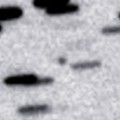
|
Now it is 16.0 mag (Jan. 3, Taras Prystavski). It keeps 17-18 mag for a long time from 2014 to 2016.
Date(TT) R.A. (2000) Decl. Delta r Elong. m1 Best Time(A, h)
Jan. 3 13 18.07 -21 45.1 5.488 5.338 76 17.2 5:38 (346, 32)
Jan. 10 13 15.29 -22 15.5 5.358 5.338 83 17.1 5:38 (354, 32)
|

|
It brightened up to 13.8 mag from summer to autumn (Sept. 16, Taras Prystavski). Now it is fading rapidly. It has already faded down to 17.1 mag (Dec. 19, Taras Prystavski). It keeps observable in good condition until February when the comet will be fainter than 18 mag.
Date(TT) R.A. (2000) Decl. Delta r Elong. m1 Best Time(A, h)
Jan. 3 0 35.06 -1 16.4 2.610 2.715 85 17.3 18:30 ( 19, 52)
Jan. 10 0 43.28 -0 18.9 2.732 2.750 80 17.5 18:35 ( 29, 51)
|
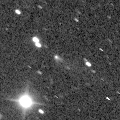
|
Now it is 18.1 mag (Dec. 26, D. Buczynski). It was observed at 17 mag from 2013 to early 2014. It will be observable at 17.5 mag in good condition again from autumn to winter in 2014. But recently, it is fainter than this ephemeris.
Date(TT) R.A. (2000) Decl. Delta r Elong. m1 Best Time(A, h)
Jan. 3 8 32.04 12 44.9 2.433 3.346 154 17.3 1:45 ( 0, 68)
Jan. 10 8 27.63 12 50.9 2.411 3.361 162 17.3 1:13 ( 0, 68)
|
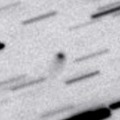
|
Now it is 16.9 mag (Oct. 30, Toshiyuki Takahashi). It keeps observable at 17-18 mag for a long time from 2013 to 2016. It keeps locating high in the Northern Hemisphere. It keeps locating very low in the Southern Hemipshere.
Date(TT) R.A. (2000) Decl. Delta r Elong. m1 Best Time(A, h)
Jan. 3 17 15.81 44 58.5 6.776 6.529 71 17.3 5:38 (236, 36)
Jan. 10 17 18.56 45 42.2 6.748 6.536 73 17.3 5:38 (236, 40)
|

|
Now it is 17.9 mag (Dec. 30, Catalina Sky Survey). It will brighten up to 11 mag in 2015 autumn. In this apparition, it is observable until the highlight while the comet is brightening.
Date(TT) R.A. (2000) Decl. Delta r Elong. m1 Best Time(A, h)
Jan. 3 12 51.78 -1 15.0 2.828 2.989 89 17.5 5:38 (349, 53)
Jan. 10 12 57.28 -1 35.6 2.689 2.949 95 17.3 5:38 (359, 53)
|
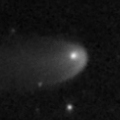
|
Now it is between 16.2 mag (Dec. 20, Taras Prystavski) and 20.5 mag (Dec. 20, B. Lutkenhoner). Extremely diffuse, and hard to observe.
Date(TT) R.A. (2000) Decl. Delta r Elong. m1 Best Time(A, h)
Jan. 3 3 11.48 -2 55.6 8.826 9.361 120 17.4 20:21 ( 0, 52)
Jan. 10 3 9.77 -2 31.7 8.961 9.397 113 17.4 19:51 ( 0, 53)
|

|
Now it is 17.8 mag (Dec. 30, G. Linan). It was observed around 17-18 mag in early 2014. It will be observable around 17-18 mag again from 2014 autumn to 2015 spring, in excellent condition in the Northern Hemisphere. It is not observable in the Southern Hemisphere.
Date(TT) R.A. (2000) Decl. Delta r Elong. m1 Best Time(A, h)
Jan. 3 10 56.12 56 10.4 4.517 5.143 124 17.4 4:08 (180, 69)
Jan. 10 10 53.79 56 33.0 4.479 5.149 128 17.4 3:38 (180, 69)
|
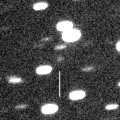
|
Now it is 18.3 mag (Dec. 20, S. Hellmich, S. Mottola, O. Tiefenbacher). Now it is around the aphelion. In the Northern Hemisphere, it is observable at 18 mag in good condition from winter to spring. It locates somewhat low in the Southern Hemisphere.
Date(TT) R.A. (2000) Decl. Delta r Elong. m1 Best Time(A, h)
Jan. 3 9 14.28 26 35.6 3.789 4.650 147 17.7 2:27 ( 0, 82)
Jan. 10 9 10.68 27 3.3 3.730 4.641 155 17.7 1:56 ( 0, 82)
|

|
Now it is 17.9 mag (Dec. 29, Catalina Sky Survey). It keeps observable at 17 mag from winter to spring. It is observable in excellent condition in the Southern Hemisphere. But it locates somewhat low in the Northern Hemisphere.
Date(TT) R.A. (2000) Decl. Delta r Elong. m1 Best Time(A, h)
Jan. 3 11 54.20 -9 57.8 2.870 3.180 99 17.8 5:06 ( 0, 45)
Jan. 10 11 53.76 -12 0.8 2.759 3.166 105 17.7 4:38 ( 0, 43)
|
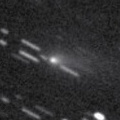
|
It brightened up to 2 mag by unusual major outburst in 2007. It brightened up to 12.6 mag in this apparition (June 25, Taras Prystavski). Now it is fading. It has already faded down to 16.8 mag (Dec. 20, Taras Prystavski). In the Northern Hemisphere, it keeps observable until it fades out in 2015. In the Southern Hemisphere, it keeps extremely low after this.
Date(TT) R.A. (2000) Decl. Delta r Elong. m1 Best Time(A, h)
Jan. 3 4 5.17 46 19.0 2.074 2.890 139 17.7 21:14 (180, 79)
Jan. 10 4 3.12 45 12.5 2.156 2.920 133 18.0 20:45 (180, 80)
|

|
Now it is 16.7 mag (Dec. 22, Taras Prystavski). It keeps observable at 17 mag in good condition from winter to spring.
Date(TT) R.A. (2000) Decl. Delta r Elong. m1 Best Time(A, h)
Jan. 3 9 20.33 11 24.1 2.806 3.640 142 17.9 2:33 ( 0, 66)
Jan. 10 9 17.89 11 8.1 2.734 3.623 150 17.8 2:03 ( 0, 66)
|
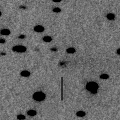
|
Now it is 17.2 mag (Dec. 28, Mt. Lemmon Survey). It keeps observable at 17-18 mag from summer to winter in excellent condition in the Northern Hemisphere. It locates somewhat low in the Southern Hemisphere.
Date(TT) R.A. (2000) Decl. Delta r Elong. m1 Best Time(A, h)
Jan. 3 6 40.78 21 39.4 1.714 2.697 177 17.8 23:49 ( 0, 77)
Jan. 10 6 34.44 22 8.9 1.755 2.726 168 18.0 23:15 ( 0, 77)
|

|
It keeps 18 mag from 2014 to 2015. In 2015, it keeps observable in good condition from winter to spring.
Date(TT) R.A. (2000) Decl. Delta r Elong. m1 Best Time(A, h)
Jan. 3 11 0.52 -7 57.0 5.473 5.912 111 17.9 4:12 ( 0, 47)
Jan. 10 10 59.79 -8 31.6 5.384 5.920 118 17.9 3:44 ( 0, 46)
|

|
Now it is 18.8 mag (Dec. 20, K. Hills). It keeps 18 mag for a very long time from 2013 to 2018. It locates high in the Southern Hemisphere. But it locates somewhat low in the Northern Hemisphere.
Date(TT) R.A. (2000) Decl. Delta r Elong. m1 Best Time(A, h)
Jan. 3 12 21.92 -22 46.1 9.159 9.175 87 17.9 5:34 ( 0, 32)
Jan. 10 12 22.68 -23 3.0 9.046 9.173 94 17.9 5:07 ( 0, 32)
|
|
![]()
 284P/2013 J1 ( McNaught )
284P/2013 J1 ( McNaught ) 305P/2014 N1 ( Skiff )
305P/2014 N1 ( Skiff ) P/2014 X1 ( Elenin )
P/2014 X1 ( Elenin ) C/2014 W2 ( PanSTARRS )
C/2014 W2 ( PanSTARRS ) (347449) 2012 TW236
(347449) 2012 TW236 C/2013 G9 ( Tenagra )
C/2013 G9 ( Tenagra ) P/2014 L2 ( NEOWISE )
P/2014 L2 ( NEOWISE ) 119P/Parker-Hartley
119P/Parker-Hartley C/2012 K8 ( Lemmon )
C/2012 K8 ( Lemmon ) 22P/Kopff
22P/Kopff C/2009 F4 ( McNaught )
C/2009 F4 ( McNaught ) C/2013 U2 ( Holvorcem )
C/2013 U2 ( Holvorcem ) 65P/Gunn
65P/Gunn C/2014 W6 ( Catalina )
C/2014 W6 ( Catalina ) 17P/Holmes
17P/Holmes C/2014 W11 ( PanSTARRS )
C/2014 W11 ( PanSTARRS ) 191P/McNaught
191P/McNaught C/2013 TW5 ( Spacewatch )
C/2013 TW5 ( Spacewatch ) C/2013 C2 ( Tenagra )
C/2013 C2 ( Tenagra )![]()


















































